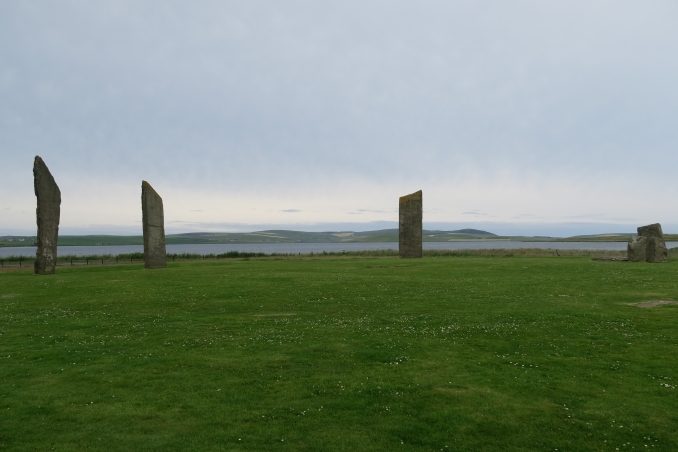Mainland, Orkney

Kirkwall/Baile na-h-Eaglais
Kirkwall/Baile na-h-Eaglais is the capital of Orkney, located in the centre of Mainland and the port has ferry services to Aberdeen and Lerwick as well as the other main north islands in the archipelago. In the town is the Orkney Museum, Tankerness House, Broadstreet, Kirkwall. It is housed in a sixteenth century town house. The museum has an important collection and gives the history of Orkney from the Mesolithic, Neolithic and Pict times through to the Viking period until the present day. The museum is open throughout the year from Mon-Sat 10:30-17:00. Also in Kirkwall is St Magnus Cathedral which was built for the Norse Earls of Orkney. Construction of the Cathedral, which was part of the Norwegian church, began in 1137 and it has been added to over subsequent centuries. Next to the Cathedral are the ruins of the Bishop's Palace and Earl's Palace. The Bishop's Palace was built at the same time as the Cathedral and was home to the first Bishop William the Old (William Sennex). The Earl's Palace was constructed from 1607 by Patrick Stewart, 2nd Earl of Orkney. It's ruins lie close to the cathedral in the centre of Kirkwall.
Grain Earth House
This is a well built Iron Age Souterrain supported on pillars and located west from Kirkwall off the A965 at Hatston Industrial Estate at the lower junction of Scott's Road.
Wideford Hill Cairn
This tomb dates back to about 3000 BC. Similar to the internal arrangement at Maes Howe with a passage, main chamber and side cells. It is located west from Kirkwall at Wideford Hill. The site is entered by via a ladder from the top of the cairn and requires a torch.
Cuween Hill Cairn
This is a Neolithic chambered cairn. The tomb is entered along a passage leading to a main chamber made up of corbelled stonework and side cells. The remains of some eight humans were found in the chamber (mostly skulls) along with the skulls of twenty four small dogs. The site is located on a hillside off the old Finstown Road from Kirkwall south of the A965. The site is signposted to a car park and then a walk of about 250 metres.
Maeshowe
This is a Neolithic chambered cairn and passage grave with many similarities to the Newgrange site in Ireland. Encasing the tomb is a mound of some 24 feet in height and about 115 feet in diameter. Within the mound is a complex of chambers and passages built with large stone slabs. The central chamber is built to align with the light of the winter solstice as with the the Irish Newgrange site pointing to linked cultures. There are a number of runic inscriptions in the tomb left by Vikings who broke into the tomb in the mid-twelfth century. The site is open daily throughout the year and is located off the A 965 west from Finstown, southeast from Loch Harray towards Stennes.
Barnhouse Stone
This is a standing stone of about ten feet in height in a field close to Maeshowe. It is north of the A965 about half a mile south of the stones at Stennes.
Standing Stones of Stenness
West from Kirkwall and Finnstown along the A965 towards Stromness on the south-eastern shore of Loch Stenness. There are four stones of 12 original remaining, standing up to 16 feet in height. The site is dated to 3100 BC and was surrounded by a ditch and earth bank.
The Comet Stone
This is a standing stone which is located to the southeast of the Ring of Brodgar. The stone which is about 5feet 9inches in height and could have been part of a ceremonial route between the Stones of Stenness and the Ring of Brodgar.
Ring of Brodgar
This is a Neolithic stone circle and henge possibly erected around 2500 BC-2000 BC. It is located on a narrow strip of land between Loch Harray and Loch Stenness about a mile northwest from The Standing Stones of Stenness. Twenty seven stones remain of a larger ring set in a circular ditch over 340 feet in diameter. The stones vary in height from 7 feet to over 15 feet.
The Watchstone
This is a standing stone of about nineteen feet in height and was once one of two. The stone is to the northwest of the Stones of Stennes.
Broch o' Borwick
This Broch is thought to date from the first millennium BC and the remaining walls standing at nearly three meters in height. The southeast facing entrance leads to a passage that goes to the remains of a small guard cell. The side of the broch closest to the sea has been subject to coastal erosion and stands about eighty feet above the sea. The broch is north from Yesnaby along the cliff top overlooking Borwick Bay mid-way to Scara Brae.
Skara Brae
This is a Neolithic settlement made up of ten houses estimated to date back to about 3200 BC. The houses contain a number of stone built pieces of furniture and have an average size of about 430 square feet with a hearth. A number of items have been found on the site including artefacts made of whalebone, walrus ivory and other fish and animal bone made into practical day to day living utensils as well as items of decoration. A number of carved stone balls were also found with similar carvings on lintels and bed posts. The site is open throughout the year and is located southwest of Skaill Home farm off the B9056. Many of the items found at the site are at the visitors centre close by.
The Stane o' Quobune
This is a standing stone of about thirteen feet in height dating from the second millennium BC. It is a good example of a number of such standing stones in Orkney. The site is located to the west of Loch of Boardhouse of the A967 in Birsay close to Stanger.
Birsay
Here is the remains a Viking monastic settlement on the Brough of Birsay and the place where legend says that St Magnus (Earl Magnus Erlendsson) was educated.
Broch o' Gurness
This is the remains of an Iron Age Fort located north of the A966 overlooking Eynhallow Sound looking toward Rousay. Discovered in 1929 in what was known as the Knowe o' Aikerness. It is thought to date between 200 BC-100 BC and is one of about fifty known to date in Orkney. The broch is about sixty-five in diameter internally surrounded by high walls and has the remains of stone dwellings. The site was surrounded by three ramparts and ditches.
Minehow
This is an Iron Age stone built chamber. There are two levels containing four chambers dug into an earthen mound. The exact purpose of the site is not known but is thought to have been of ritual importance. It is located in Tankerness about eight miles southeast from Kirkwall.
Celtic nation:
- Scotland
Itinerary:
- Scotland Orkney Islands
Place type:
- Natural






